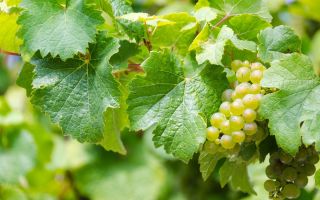Content
Grape berries are a source of nutrients needed by the human body. But foliage is not inferior to fruits in terms of the content of vitamins and minerals. They are used for cooking in many oriental cuisines and in folk medicine. And the benefits and harms of grape leaves have been studied by US doctors, who included them in the national list of dietary products with a number of valuable qualities.
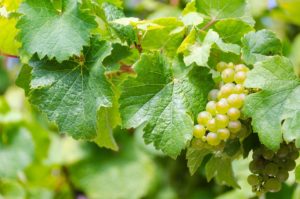
Composition and calorie content of grape leaves
Grape leaves are of great benefit to the human body and practically do not harm it due to their rich beneficial composition. They contain vitamins of group B, K, A, E, PP, ascorbic acid, beta-carotene. In addition, the healing properties of foliage are enhanced by the content of Potassium and Calcium, Magnesium, Sodium, Zinc, Copper and Manganese, Phosphorus, Selenium and other minerals.
Nutritional value and calorie content of the product per 100 g
|
Name- dying |
Proteins, r |
Fat, g |
Carbohydrates, g |
Fatty Acids, g |
Sugar, g |
Water, g |
Ash, g |
Food Fiber, g |
Kcal |
|
Leaves grapes |
5,6 |
2,12 |
6,31 |
0,335 |
6,3 |
73,32 |
1,65 |
11 |
93 |
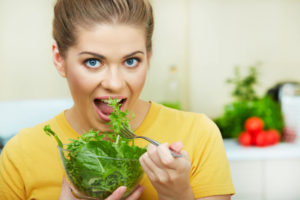
Useful properties of grape leaves
Grapes are a popular affordable treat loved by many. But few people use grape leaves as a food product and know about their benefits and harms to the body. Studies have been repeatedly carried out that have proven the healing properties of berry greens. The results of their study indicate that foliage, especially the Amur variety, can be used as a means of preventing Alzheimer's disease. Among the medicinal properties of green grape leaves, one can single out their ability:
- stop bleeding and relieve inflammation;
- relieve pain;
- strengthen immunity;
- treat indigestion;
- help in the treatment of rheumatism;
- normalize the work of the digestive system and gastrointestinal tract;
- calm the nerves;
- help to overcome depression.
Thanks to vitamin A, the leaves are a powerful antioxidant. They remove toxins and toxins from the body. Greens have a rejuvenating effect and help slow down the aging process. The use of the foliage of the favorite fruit of the god of winemaking and viticulture, Dionysus, helps to strengthen the health of the eyes, skin and hair.
The healing properties of grape leaves are enhanced by the acids they contain. Omega-3 helps in the treatment of joints, normalizes the work of the heart, and is a prophylactic agent for malignant neoplasms. Chewing the leaves helps to cleanse the oral cavity from bacteria and teeth from plaque, preventing the appearance of periodontal disease. But do not chew more than one leaf a day, so as not to harm the enamel.
The use of grape leaves in traditional medicine
Thanks to their beneficial properties, grape leaves are far from the last place in alternative medicine. They are used both fresh and dried. Medicinal infusions, decoctions, teas are prepared from them.The foliage as a whole or crushed to a pasty state is used for compresses that are applied to wounds to speed up their healing. With varicose veins, to reduce vasodilation and the formation of a mesh, it is good to use red grape leaves, the benefits of which have been noticed by pharmacologists. From green raw materials, preparations are made for the treatment of varicose veins.

Grape leaf juice
Freshly squeezed juice from the leaves is very beneficial for the digestive tract. Its use:
- reduces acidity;
- helps to stop vomiting and vomiting in case of intestinal disorders;
- slows down internal bleeding and helps to stop them;
- helps to cope with bouts of nausea;
- removes sand and stones from the kidneys and bladder;
- has an antibacterial effect;
- has a positive effect on the genitourinary system.
In addition, juice from grape leaves is a good aphrodisiac that strengthens men's health, increases attraction to the opposite sex and enhances potency. But you should not abuse it, so as not to get unwanted harm instead of benefit.
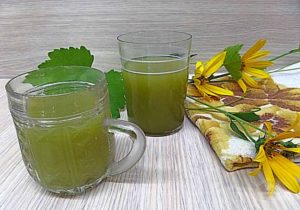
Infusion of grape leaves
Grape infusion is a useful remedy that normalizes and improves the functioning of the nervous and cardiovascular systems. It is an excellent antioxidant that detoxifies the body. To prepare the infusion, you need to take fresh grape leaves and hot water. Cooking process:
- Rinse the foliage under running water.
- Remove cuttings.
- Crumple a little and fill 1/3 of a liter can with raw materials.
- Pour boiling water to the top.
- Close hermetically.
- Leave to infuse in a dark place for 21 days at room temperature.
During the infusion period, the agent must be shaken every couple of days. The infusion should be consumed once a day before the main meal. To do this, 10 drops of the product should be diluted in 3 tbsp. l. water. The treatment lasts for two weeks. Then the course should be suspended for 7 days and repeated if necessary.
The shelf life of the infusion of useful grape leaves is 3 months at room temperature and 6 months in the refrigerator.
Decoction of grape leaves
To prepare a decoction that is useful for its healing properties, grape leaves should be prepared by washing them and cleaning them from petioles and damaged parts. Then knead to get a mass resembling gruel. The resulting raw material in the amount of 100 g, pour 0.5 liters of water. Put the container with the composition on low heat, cover it loosely and cook for 60 minutes. The water should evaporate to 1/3 of the amount poured in. Filter the finished broth through cheesecloth and pour into a clean glass dish.
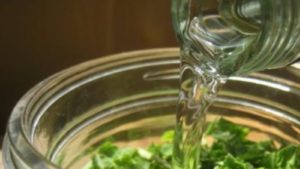
Take a medicinal broth for 2 tbsp. l. before main meals for 21 days. Then take a two-week break and, if necessary, repeat the course of treatment. You can store a useful grape product for 6 - 8 months by tightly closing and placing in a cool place.
Tea with grape leaves
The benefits of tea are higher if brewed from dried grape leaves. During drying, the concentration of beneficial acids and bioflavonoids is maximized.
To dry the foliage, it should be washed, cleaned from damaged parts, dried, folded in envelopes and laid out on a baking sheet. Place in the oven for 6 - 8 hours at 65 degrees. The door does not need to be closed. Store dry foliage in a paper bag or cloth bag for no more than 12 months, periodically ventilating.
To make tea from grape leaves, for the benefit of strengthening the immune system, chop the dried herbs, pour into a teapot, pour boiling water over and leave for 15 minutes. Before use, dilute the tea leaves with hot boiled water in a 1: 1 ratio. If tea is used as a remedy, it should be drunk for 4 weeks three times a day. The daily dose should not exceed 750 ml.As a preventive measure against colds and viral infections, it is enough to drink 250 ml of tea a day.

Grape leaves in home cosmetology
Useful properties and minimal potential for harm to health contribute to the fact that grape leaves are used for cosmetic purposes. Masks with exfoliating and rejuvenating effect are prepared from green raw materials. They smooth out wrinkles and slow down the appearance of new ones.
The gruel made from fresh leaves is used to cleanse the pores. Its benefit is that the product refreshes the skin and returns a healthy color to the face. To relieve eye fatigue, you can make compresses from the leaves. The beneficial elements contained in greens help relieve puffiness and redness, reduce bags, while not harming the eyes.
To strengthen and restore hair color, it is recommended to add grape infusions and decoctions to shampoos and rinses. They help in the fight against excessive scalp oiliness and dandruff.
Recipes with grape leaves
In eastern countries and even in the Transcarpathian region of Ukraine, various dishes are prepared from the healthy foliage of grapes, in which the product is used boiled, fried, baked, stewed. Unlike many vegetables, berries and fruits, grape greens do not lose their healing properties and taste after heat treatment. Products that combine perfectly with leaves include meat, fish, smoked meats, and legumes.
Classic dolma with grape leaves
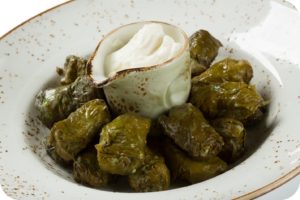
Dolma in grape leaves is considered a Turkish national dish that preserves all the benefits of the plant. It is prepared from both fresh and canned leaves. To cook Turkish cabbage rolls, you need to boil 100 g of rice until half cooked, finely chop 2 onions, parsley, dill, basil and cilantro. Mix everything with 500 g of ground beef. Instead of beef, you can use another type of meat. Mix the resulting composition well, while salt and seasoning with spices.
To make the leaves soften a little and curl better, they need to be placed in boiling water for 5 minutes. Then put the minced meat in the middle of the sheet and wrap. Place the blanks in a saucepan, the bottom of which should first be lined with grape leaves. Pour water into a container and add a couple of garlic cloves. Cook for 30 - 40 minutes over medium heat, covered with a lid.
Grape leaf salad
The sour taste of grape greens adds spice to salads. One of the tastiest is Hercules. To prepare it, you need to chop 300 g of white cabbage and mash it. Add 100 g of herbs and 30 g of finely chopped leaves. Add one coarse apple to the cabbage. Mix the ingredients thoroughly and pepper. Prepare garlic sauce. To do this, squeeze two garlic cloves through a garlic dish and mix with a glass (200 ml) of kefir. Season the salad with sauce and serve.
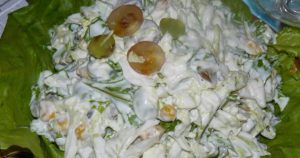
Grape leaves for the winter
It is not difficult to get grape foliage in the summer, but in order to get the benefits of its use in winter, you can make preparations according to the following recipe.
- Collect the young leaves and sterilize the jars.
- Soak the foliage in cold water for 60 minutes.
- Rinse every single sheet.
- Remove cuttings and thick veins.
- Fold the leaves in about 10 pieces and roll them into tight tubes.
- Put in jars.
- Pour boiling water over and stand for 15 minutes, covering with lids.
- Drain the water.
- Boil tomato juice and pour over.
- Roll up the key.
- Wrap up with a blanket and hold until the contents of the cans have completely cooled.
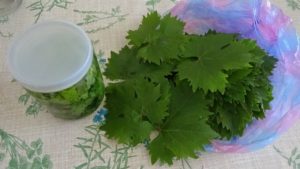
Harm of grape leaves and contraindications
Even though there are many beneficial medicinal properties, in some cases, the use of grape foliage can be harmful to health.Their use should be abandoned for those who suffer from tuberculosis and diabetes. The use of the leaves is also contraindicated for obesity, heart failure, exacerbation of ulcers and gastritis.
Taking grape greens can cause gas formation, so it should be abandoned for colitis. Leaves are contraindicated in the last month of pregnancy and during breastfeeding, as their use slows down milk production and can harm the baby.
Collection and storage of grape leaves
It is preferable to collect raw materials from May to June. You need to choose young healthy leaves with a smooth, soft surface and thin veins. You can store grape foliage fresh, frozen, canned. Greens can also be pickled or salted.
For freezing, the leaves are rolled into tubes, folded into a bag and placed in the freezer. To keep them fresh, each must be rolled up, put in jars and sterilized in the oven for half an hour. Then put in a cool dark place.
For pickling, the leaves need to be rolled up and folded into jars, pour marinade and insist overnight. Then cover and store in the refrigerator. For the marinade, you need to boil 1 liter of water with 2 tbsp. l. salt.
To preserve the grape greens, place the twisted leaves in boiling water for 3 seconds, then in cold water. Then place in jars and pour brine at the rate of 1 liter of water per 45 g of salt. Insist for 2 - 3 days, then add 1 tsp. vinegar and roll up.
For storage in salted form, place the leaves in a container, pour 10% saline solution and hide in a cool place.
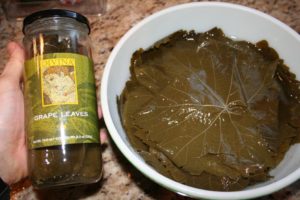
Conclusion
The benefits and harms of grape leaves are becoming more and more known. When used correctly, they will not only add spice to dishes, but also help improve health. The big advantage of grape foliage is that they do not lose their beneficial properties during the entire period of their storage.

